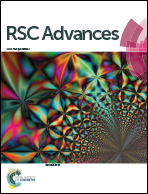[Cu3(BTC)2]-polyethyleneimine: an efficient MOF composite for effective CO2 separation†
Abstract
Increased CO2 concentration in the earth’s atmosphere results in global warming and has increased concerns towards the development of efficient strategies for carbon capture and storage. CO2 separation from flue gas is one of the most challenging areas. Here, a Cu-BTC MOF and a series of polyethyleneimine (PEI) incorporated Cu-BTC composites (Cu-BTC–PEI) with different loading amounts of PEI have been developed for CO2 separation. A significant increase in CO2 adsorption capacity was observed with Cu-BTC–PEI adsorbents. Detailed characterization of the developed adsorbents was done using XRD, SEM, BET surface area and IR. The synthesized adsorbents show good CO2/N2 selectivity for a designed flue gas composition containing 15 vol% CO2 and the remainder as N2. 2.5 wt% PEI loaded Cu-BTC (Cu-BTC–PEI-2.5) has shown a CO2 adsorption capacity of 0.83 mmol g−1 at a pressure of 0.15 bar and 25 °C which is almost double that of Cu-BTC in similar conditions. But at an elevated pressure of 5 bar and 25 °C, 1 wt% PEI loaded Cu-BTC (Cu-BTC–PEI-1) performed even better with a CO2 adsorption capacity of 10.57 mmol g−1. Better adsorption capacity and selectivity for CO2 was obtained with Cu-BTC–PEI composites and they are good aspirant adsorbents for CO2 separation from flue gas.
![Graphical abstract: [Cu3(BTC)2]-polyethyleneimine: an efficient MOF composite for effective CO2 separation](/en/Image/Get?imageInfo.ImageType=GA&imageInfo.ImageIdentifier.ManuscriptID=C6RA10465G&imageInfo.ImageIdentifier.Year=2016)


 Please wait while we load your content...
Please wait while we load your content...